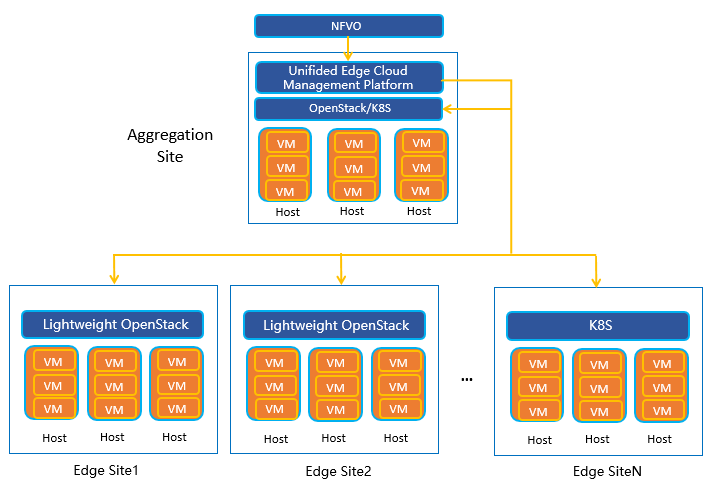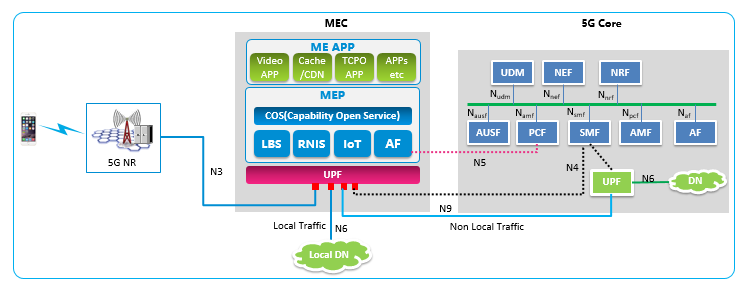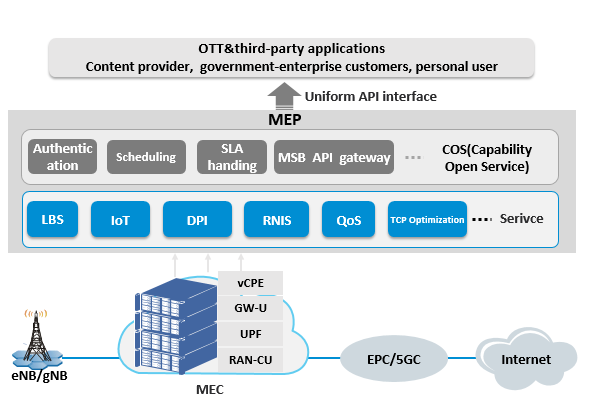With the rapid development of mobile Internet and the Internet of Things, 5G services have presented diversified features. 3GPP has defined three 5G application scenarios: eMBB (Enhanced Mobile Broadband), uRLLC (Ultra Reliable Low Latency Communication) and mMTC (Massive Machine Communication). The eMBB scenario provides large-traffic mobile broadband services with a peak rate of over 10Gbps and a bandwidth requirement of up to dozens of Gbit/s, such as high-speed download, HD video and VR/AR, etc, meeting higher requirements for digital life, but it will cause great pressure on the wireless backhaul network. Therefore, it is necessary to deploy services to the network edge to implement local traffic distribution. The uRLLC scenario provides ultra-reliable and ultra-low latency communication, such as automatic driving, industrial control and telemedicine. The end-to-end 99.999% is required to be highly reliable and be less than 1 ms, thus meeting the higher requirements of the digital industry. In this case, services need to be moved to the network edge to reduce the network delay caused by network transmission and multi-level services forwarding.
Due to the application characteristics of these two 5G scenarios, traditional large-scale and centralized telecom cloud construction cannot meet these requirements. Therefore, the deployment mode of telecom cloud needs to be changed to meet the service requirements in different 5G scenarios. Mobile/Multi-access Edge Computing (MEC) cloud just meets this special scenario. As a key technology in 5G evolution, MEC can be used to provide cloud computing capabilities and IT services for edge applications closer to the mobile network edge of customers. MEC is featured with ultra-low latency, ultra-large bandwidth, localization, and high real-time analysis and processing. On the one hand, MEC is deployed at the edge of the network, and services run on the edge devices, so the response is more rapid and the delay problem can be solved. On the other hand, MEC moves the content and computing capability down to the end, provides intelligent traffic scheduling, distributes services and caches contents locally, so that some regional services can be terminated locally. This improves user experience and reduces the resource usage of the backbone transmission network and upper-layer core network. Therefore, MEC is the best choice for edge cloud deployment in 5G networks.
Location of MEC Edge Cloud
MEC edge cloud is not restricted by the network deployment mode. In general, MEC edge cloud can be flexibly deployed in accordance with different service scenarios and delay requirements,such as in different scale edge DCs or local DCs, see the following figure.

Figure 1 Location of MEC Edge Cloud
By deploying an MEC cloud at the edge, the computing capability of the cloud can be effectively extended from the center to the edge to implement fast service processing and local forwarding, meeting the diversified application scenarios of 5G.
Form of MEC Edge Cloud
Considering about the limited spaces, heat dissipation, load-bearing, and deployment costs, rack servers based on the X86 processor are best option as the hardware infrastructure of MEC edge cloud. These servers are small in size, low in power consumption, and high in computing density, and are very applicable to deploy in the edge equipment rooms with low environmental requirements.
MEC edge cloud usually provides a unified virtualization software environment and resource management for upper-layer MEC applications based on a specific cloud platform (such as Openstack). MEC applications are deployed on the edge cloud platform in the form of virtual machines, and can be flexibly deployed according to different scenarios. For example, applications strongly related to traffic forwarding are usually deployed on edge DC, including vCPE, OLT-U, DU, BNG-U, UPF/GW-U and MEP, to meet the service requirements of large bandwidth and low delay.
ZTE MEC Edge Cloud Deployment Solution
To better meet the requirements of multi-service scenarios in the 5G era, ZTE has proposed a complete and 5G-oriented MEC edge cloud deployment solution. This solution has the following five highlights:
1. Deploying an Lightweight Edge Cloud Platform
Restricted by the environment of the edge site equipment room, the deployment scale of the MEC edge cloud is usually small, and the available hardware resources are limited because the number of servers deployed on a single site is limited.. However, a lot of resources are occupied by infrastructure platforms such as Openstack and management modules for installation , resulting in the waste of resources on the edge cloud. Therefore, MEC edge cloud needs to be reduced and deployed with a light-weight deployment to reduce the resources occupied by the platform and management part and improve the resource usage of the edge cloud. It includes the following measures:
- First, make a light-weight Openstack: keep the necessary components, remove redundant components, and reduce the occupation of computing and storage resources on the edge cloud.
- Dual-core (VM+Container) deployment solution can be used to implement the light-weight deployment of upper-layer applications, facilitating fast deployment and upgrade.
- In addition, the light-weight Openstack can share physical resources with the computing nodes on the edge cloud, which does not exclusively occupy physical resources to reduce the resources occupation of the control part.
The light-weight MEC edge cloud deployment solution of ZTE is shown in Figure 2. By deploying light-weight Openstack, the number of components is reduced by 60%, the number of resources required for intallation is reduced by 75%, and the number of resources required for management is reduced by 10%. This not only greatly reduces the resource requirements for edge cloud, but also improves the management efficiency of MEC edge cloud.

Figure 2 Lightweight MEC Edge Cloud Deployment Solution
In addition, to improve the adaptability and resource density of MEC edge cloud deployment, ZTE and Intel jointly launched a dedicated server platform OEP600 (Open Edge Platform 600) for MEC edge cloud deployment. The platform adopts a small-size all-in-one machine, with the chassis depth of only 450 mm. CPU uses the latest Intel ® Xeon® Scalable Processors, providing higher computing performance for edge computing. It is also applicable for wide-temperature scope,strong heat dissipation capability and easy maintenance that can meet the requirements of multiple deployment environments, and achieves the best balance between performance and costs. In the MEC Technology and Industry Development Summit 2019, ZTE's MEC Edge Cloud Server Platform OEP600 won the 2018-2019 MEC Technology Innovation Award, fully demonstrating ZTE's leading innovation capability and technical level in the edge computing field.
2. Deploying an Unified Edge Cloud Management Platform
Due to the large quantity and scattered locations of MEC edge clouds, the planning, deployment, O&M of MEC edge clouds are extremely complicated. Therefore, it is necessary to deploy an MEC edge cloud unified management platform (see Figure 2) on convergence site to make unified management for MECs on distributed edge sites. Only computing nodes and storage nodes are deployed on each edge site , reducing the resource usage of management modules.
The unified management of the MEC edge cloud inlucdes two aspects: Resource management and O&M management.
- Unified resource management
It provides unified management and allocation of resource pools (such as computing, storage, and networks) on edge nodes in a unified way, provides a unified GUI to monitor the topology, alarms, performance, capacity, and other information of physical resources on edge nodes in a centralized manner, also provides logs and alarms to help system administrator orientate breakdown quickly. NFVO is deployed on convergence site and only integrates with unified MEC edge cloud management platform to provide unified orchestration and deployment of multi-VMs and containers on all edge clouds.
- Unified O&M management
It provides a unified O&M management for VIMs in all edge clouds, including site management, user/tenant management, function configuration, mirroring distribution, centralized backup, upgrade/patch management, routine check and API distribution etc. It aslo provides unified FCAPS management, unified alarm, configuration and performance statistics, provides smart and convenient O&M tools for fast installation and upgrade, fast routine check and commissioning check, fast fault analysis and locating, and log analysis to improve O&M efficiency.
3. Deploying 5G UPF on MEC for Local Traffic Offload
To meet the feature requirements of large bandwidth and low latency in 5G application scenarios, MEC edge cloud will be deeply integrated with the 5G network architecture during deployment. Some fucntions of MEC suah as service offload, policy control, and QoS guarantee will be implemented based on 5G standard. Based on the C/U separation architecture of the 5G core network, the user plane element such as UPF (User Plane Function) can be deployed on edge DC to reduce the transmission delay and implement local traffic offload. Control-plane element such as the SMF(Session Management Funtion) is deployed in central DC to control UPFs deployed in edge DCs, such as making unified configuration and issue of traffic distribution policies for UPFs.
The 5G UPF local traffic offload solution is shown in Figure 3. the local trafffic offload policys are configured and delivered from PCF to SMF. SMF control the dispatch of all traffic to different UPFs. SMF selects local UPF in edge DC by policys and control local UPF to offload local traffic. For non-local traffic, SMF controls local UPF forwarding traffic to the central UPF in central DC for processing. It avoids all traffic going through central DC by local traffic offload, reduces the load and cost of backbone network and core network, and improves transmission efficiency of packet data and user experience.

Figure 3 5G UPF Local Traffic Offload Solution
4. Provides hardware acceleration for MEC edge cloud to improve performance
MEC edge cloud hardware generally uses x86 universal servers. However, the x86 universal servers have low performance in processing specific service, resulting in a low price/performance ratio, and cannot meet commercial deployment requirements in 5G scenarios. Different hardware and software acceleration solutions should be considered for different services.
- For computing intensive services, such as 5G CU PDCP air interface encryption/decryption and MEC location algorithm, need consume a lot of CPU resoureces ,so special hardware acceleration is required.
- For traffic forwarding services, such as 5G UPF/GW-U, MEC local distribution, CDN and BRAS-U services require high network forwarding capability, and software and hardware acceleration of data forwarding is required.
- Video-related services: Such services as AR/VR and live video broadcast require hardware acceleration of video rendering and transcoding.
- AI field: GPU needs to be introduced for hardware acceleration for training and reasoning operations.
Currently, ZTE hardware acceleration solution supports FPGA-based GTP service acceleration, GPU-based video/audio service acceleration, and QAT encryption/decryption acceleration. Especially for 5G user plane UPF, hardware acceleration through the smart NIC is used to offload most traffic from the CPU to the smart NIC for higher forwarding performance. In particular, in the MWC Mobile World Congress held recently in Shanghai, ZTE successfully demonstrated the 5G user plane UPF solution based on the edge open hardware acceleration platform. Compared with the virtualized UPF without acceleration, this solution reduces the forwarding delay by 90% and increases the throughput by 200%. At the same time, the power consumption can be reduced by 55%, better meeting the special requirements of 5G uRLLC and eMBB for the forwarding capability of the edge data center.
5. Provides APIs to realize 5G network service capabilities exposure.
Service capability exposure is another major feature of MEC applications. MEC is deployed at the edge of network,so it is more convenient to collect the information of wireless network in real-time. And packgethe information can be exposed to the third party service applications through open interfaces, which can optimize service applications, improve user experience, and achieve in-depth integration of wireless network and services.
MEC capability exposure architecture is shown in Figure 4.To realize the capability exposure of the 5G network, MEP(ME Platform) is introduced in MEC. MEP collect the infomaiton of lower-layer network, such as the real-time location of the UE, radio link quality and roaming status, etc. and package information into different services, such as LBS, DPI, RNIS,QoS,TCPO,etc, and open these service capabilites to 3rd party applications by uniform API interface for better experience of services. For example, the 3rd party video application can improve the quality of video service by,adjusting the video playing bit rate based on RNI(Radio Network Information) and QoS information. On the other hand, MEP transfers the information feedback from upper-layer applications, such as the service duration, service period and mobile mode, to lower-layer network. The lower-layer network can optimize the resource configuration of UE (for example, allocating proper bandwidth resources for VIP users) and session management by analysis of this information.
ZTE MEP provides unified API and open network capability (LBS location capability, RNIS wireless network information capability, QoS capability, bandwidth capability) to to 3rd party applications, that provides differentiated experience for users, explores network value, and increases the value-added revenue of operators. In addition, through the standardization of open API interfaces, the development and launch of new servies are accelerated, and a good MEC industrial ecological chain will be built.

Figure 4 MEC Capability Open Architecture
Conclusion
ZTE's 5G-oriented MEC solution combines multiple software and hardware technologies, such as platform design, NFV, hardware acceleration and MEP with the 5G network, to provide a lightweight, unified, high-performance, and flexible MEC edge cloud, which making applications, services and contents can be locally deployed to meet the requirements of three scenarios(eMBB, eMBB,mMTC) in 5G network and improve user experience. ZTE wishes to cooperate with more industry partners to explore the cooperation modes of edge cloud and build a 5G-oriented edge ecosystem, promoting the commercial use of MEC edge cloud, and jointly promoting the flourishing development of 5G edge services.
ZTE supports AI with full-stack IT offering
5GC Green Engine Solution to Enable Green Internet of Everything in the Dual-Carbon Era
5GC Private Network 2.0 Empowerment and Efficiency Improvement Boosts High-Quality Development of the Industry
5G Empowers Intelligent Mining for High-quality Development of Shaanxi Coal Caojiatan Mining
ZTE and China Mobile embrace digitalization for biodiversity conservation in Panda Reserve
Three Aspects Contribute to ZTE’s Remarkable Breakthroughs in Advanced G4X Server
How 5G Private Networks Are Poised to Transform Enterprises Worldwide: All Scenario Private 5G Helps Operators to Realize Private 5G as a Service
ZTE’s commitment to servers generates robust growth of up to 60 times in past 8 years
ZTE eyes top 5 global server market share
Full-Scenario One-Stop 5G Private Network for Vertical Industries

